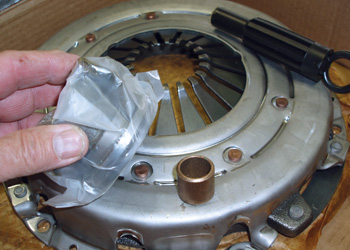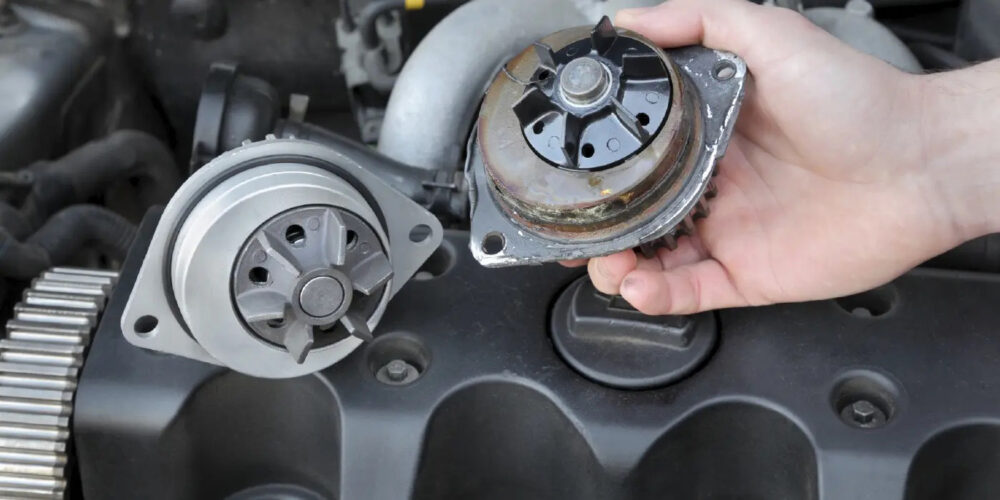Fortunately for the automotive service industry, clutch manufacturers began providing clutch repair parts packaged as a kit, generally consisting of a clutch pressure plate, friction disc, pilot bearing, release bearing and alignment tool. In most cases, the clutch parts are new and are matched to the very close tolerances demanded by compact engine compartments and transmission and trans-axle configurations. Let’s look at the nuts and bolts of clutch replacements:
 Clutch Operation
Clutch Operation
The clutch flywheel and pressure plate are attached to the engine crankshaft. The clutch disc is attached to the splined transmission input shaft. When the clutch pedal is depressed, a hydraulic master cylinder and slave cylinder is activated to depress the clutch release bearing, which in turn depresses the pressure plate release levers or diaphragm spring. In mechanical linkage applications, a cable or a bell crank and linkage activates a clutch release lever to perform the same function. When the clutch pedal is completely depressed, the clutch disc should spin freely from the flywheel and pressure plate. When the clutch pedal is released, engine torque is applied to the clutch disc.
Flywheel Grinding
Because the performance of a new clutch kit is directly related to the flywheel surface being smooth, flat and concentric to the crankshaft, cleanliness is essential when resurfacing a flywheel. Even a small grain of dirt on the flywheel grinder’s mounting plate can cause a run-out or wobble problem that lets the flywheel “drag” against the clutch disc. The minimum flywheel thickness for a specific application is important because a flywheel can be ground to the point that the disc’s torsional cushion springs can drag against the flywheel mounting bolts and furthermore, excessive grinding increases the distance that a hydraulic clutch release bearing must travel. All of the above conditions will cause a clutch release complaint.
Pressure Plates
Clutch pressure plates are either lever or diaphragm spring types that are adjusted at the factory to prevent wobble or run-out at the pressure plate friction surface. As with the flywheel, run-out tolerances on new pressure plates must practically zero to prevent clutch release complaints.
Clutch Discs
A clutch disc is a delicate assembly that is easily damaged by oil contamination, dropping it on the floor or by allowing the unsupported weight of the transmission to hang by the input shaft as the transmission is installed. A conventional clutch disc incorporates torsional cushion springs around its splined hub to absorb firing impulses from the engine and to cushion acceleration/deceleration torque. Weakened or broken torsion springs tend to aggravate clutch chatter complaints.
When looking at the edge of the disc, it’s apparent that the metal part of the disc has a waved surface that acts as a cushion between the front and rear friction linings. This quality is called the “marcel” of a clutch disc. The clutch linings or facings are riveted to the waved metal portion of the disc to allow the disc to gradually compress as it’s engaged. The marcel feature allows the clutch disc to smoothly engage the flywheel and pressure plate facings. Without correct marcel, the clutch engagement will tend to be very abrupt.
Installation Tips
Since installing the disc backward will cause the clutch not to release, the clutch disc should be clearly labeled or stamped, “flywheel side.” The disc should slide freely on the transmission input shaft. Oil contamination on clutch linings can usually be prevented by routinely replacing the engine rear main seal and transmission input shaft seal and by wiping off all friction surfaces with brake cleaner prior to installation. To prevent an unpleasant comeback, it’s important to recommend a hydraulic master and slave cylinder replacement with the new clutch. To avoid warping the pressure plate cover, the pressure plate assembly must be incrementally tightened to the flywheel. Cleaning the transmission input shaft splines and lubricating with a dry-type silicone lubricant will ease installation and help prevent clutch release complaints.











